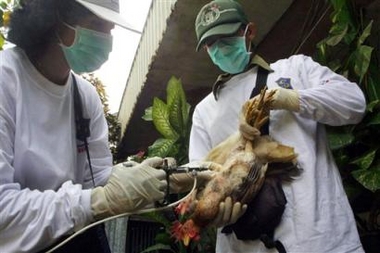The U.N. health agency described the deaths of six Indonesian family members
from bird flu as the most important development in the spread of the virus since
2003, saying it is investigating whether the disease has spread from person to
person.

Indonesian agricultural official vaccinates a
chicken Wednesday May 24, 2006 in Surabaya, Indonesia.
[AP] |
"We have a team down there, they are examining what is going on and they
can't find an animal source of this infection," said Peter Cordingley, spokesman
for the Western Pacific region of the World Health Organization.
"This is the first time that we've been completely stumped" by a source for
the infection, he said.
Six of the seven people in an extended family in northern Sumatra who caught
the disease have died, the most recent on Monday. WHO is investigating whether
the H5N1 strain of bird flu was spread among family members, though it said
Wednesday there was no evidence the virus had mutated to a form that will spread
more easily between humans, possibly sparking a pandemic.
Steven Bjorge, the WHO team leader in the village of Kubu Sembelang, said
none of the poultry in the area had tested positive for the H5N1 bird flu virus.
"We're not surprised that there is possible human-to-human transmission,"
Bjorge said. "The thing we're looking for is whether it's sustained beyond the
immediate cluster."
Isolated cases of very limited human-to-human transmission have been
documented ¡ª including one in Thailand involving a mother and child ¡ª but such
cases do not mean a pandemic flu strain has emerged. There was no indication the
Sumatra infections had spread to anyone outside the family.
Still, the scenario worries scientists.
"No matter what's going on at this stage, it's a limited transmission between
members of the same family," Cordingley said from Manila, Philippines.
"What we are looking out for is any sign of this virus going outside of this
family cluster into the general community, that would be very worrying. We
haven't seen any signs of that yet."
Bird flu has killed 124 people worldwide, more than a quarter of them in
Indonesia. So far, most human cases have been traced to contact with infected
poultry.
Bjorge said the virus that infected the family members was genetically the
same as the one found circulating in the area earlier. Tests are still being
carried out on poultry in the village.